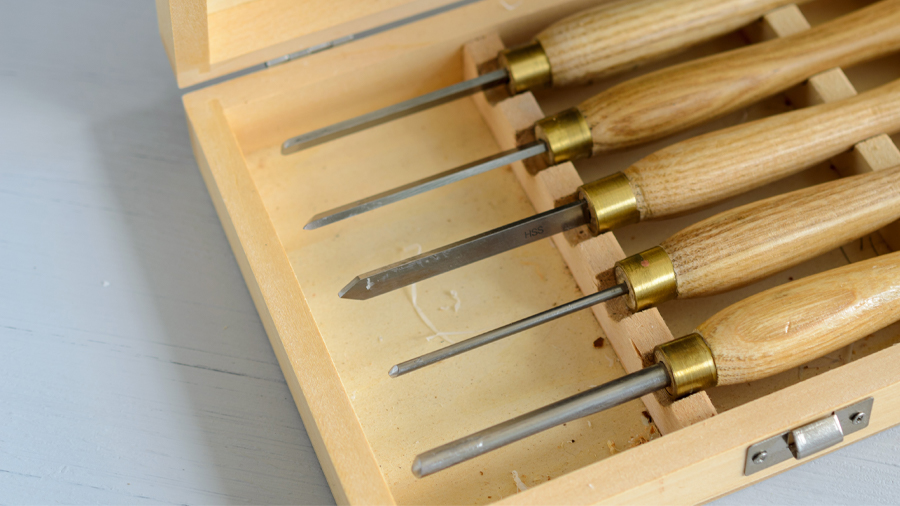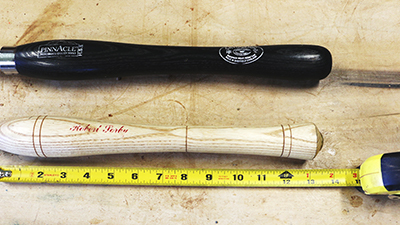Woodturning lathes are used for everything, from making baseball bats to furniture parts. The lathe’s spinning allows the woodworker to shape the piece of wood using different types of woodworking tools. These different tools usually have long handles.
Woodworking tool handles are made long mainly for leverage against the wood the operator is working against. With the high RPMs that the wood is turning, it creates resistance against the tool. Without a long handle, this resistance can cause the tool to slip as the pressure is applied and create a workpiece defect.
Woodturning tools are as important to creating fantastic objects with a lathe as the type of machine and the operator. Even the most accomplished experts will tell you the right tool in their hands makes all the difference in the world for making quality products. Let’s dive in and look at the reasons behind the length and other quality aspects of using the right woodworking tools.
Determining Woodturning Handle Length
Several factors come into play with woodturning tools. If learning to work with a lathe and create products like a pro, we need to understand some basic concepts of what tooling we need and the different concepts behind each design. First, let’s look at what tools are needed to begin woodturning and then the reasons behind handle lengths.

List of Woodturning Tools Needed
There are many types of tools for woodturning, depending on what you will be working on. If you are new to woodturning, here is a suggested starting list of tools to purchase.
- 1″ Spindle Roughing Gouge
- 3/8″ Spindle Gouge
- 3/8″ Bowl Gouge
- 3/4″ Square and Round-nose Scrapers
- Parting Tool
- 3/8″ Bedan
- Skewing Chisels
As with any woodturning set of tools, make sure you buy sharpening equipment to keep your tooling in the proper condition and sharpness. Over time, small chips and a dulled edge will result. These poor edge conditions can dramatically affect the performance of the work. More importantly, a dull edge can create a safety issue by catching or slipping on the wood. Always use sharp tools.
Reasons for Different Lengths
Woodturning tools are an extension of the person operating a wood lathe and are guides to make precision cuts into the material. We now know why these tools are long, but what determines the length?
- The lathe’s size and the parts that will be made will determine the length of the handles. The rule of thumb is for every inch passed the extending beyond the tool rest, you need five inches on the operator side. For example, If turning a 6” deep bowl on a lathe, you would need around 30” in length.
- Comfort is another factor. Depending on how tall a person is, or how high the lathe sits, the tool angle will change to allow for the best leverage while working.
- The type of material the handle is made of can also play a part in length. If the handle is tool pliable and bends during work, it may need to be shorter.
- Safety is another factor in length. If the handle is too long, it can cause issues when working within tight spaces. A handle that is too short will not allow for proper leverage and cause the operator to overexert pressure. This can be dangerous if the tool slips, and a hand or arm is allowed to slip into the spinning part.
Suggested Lengths for Woodturning Tools
| Parting Tool | 12” to 14” in Length |
| Detail Gouge | 10” to 14” in Length |
| Skew Chisel | 12” to 16” in Length |
| Roughing Gouge | 14” to 18” in Length |
| Scraper | 14” to 16” in Length |
| Bowl Gouge | 7” to 20” in Length (Depending on Bowl Size) |
What material makes the best handles for woodturning tools?
As mentioned, woodturning tool handles need to give the proper leverage when and flexibility when running the part we are working on. For this reason, the handles need to be made out of a material that provides enough sensitivity for feedback to the operator while at the same time not being too flexible. You can purchase modern handles made from aluminum and other human-made materials, but outside of laminate, most professionals prefer working with wooden handles.
Here are the different wood-based materials that are most recommended by woodturners.
- Hickory
- Cherry
- Oak (White and Red)
- Maple
- Ash
- Beech
As with most choices, each of the above has its pros and cons. Some people live cherry for not only its hardness but for its beauty. While others simply want Maple and Hickory for their hardness qualities. People even differ on what type of oak is the best due to each type’s porousness. Still, some swear by laminate handles over the pure wood forms.
End the end, your choice of handle can be determined on which one feels best in your hands while working with it. The thickness of the handle itself can change how you judge the handle also. If you don’t like a certain type of wood, try a thicker or thinner handle and see if it changes your opinion. One final note is that deciding what type of wood to use may come down to availability and cost.
Manufactured and Self-Made Handles
One thing you will find with people that work with woodturning is that many make their own handles. And why not? They certainly have the machine to do it. Let’s explore the pros and cons of each.
Manufactured Pros
- Usually standard sized: By purchasing manufactured wooden handles from the same vendor, you will probably receive the same diameter, feel and grip as the last one you ordered.
- Sound quality: If a well-known manufacturer, the quality will probably be good since it has established a controlled process.
Manufactured Cons
- There is a downside to standard sizes: When purchasing a handle, the feel of it may be the same each time, but not everyone has the same opinion on what a handle should feel or perform like.
- Lack of uniqueness: Again, manufactured tools are the same. If you like a little originality in grain structure, color, etc., these may not be for you.
- Expense: Manufactured handles may cost more for the type of wood you want.
Homemade Pro
- If you turn your own tool handles, you will have the exact thickness, finish, and grain structure you want.
- The price to make a handle out of the wood of your choice may be substantially lower. For example; If you live in an area where hickory is prevalent, you may find hickory a better choice for the cost.
Homemade Cons
- If you want consistency in a handle, especially for beginners, making your own handles may not provide the same feel each time you make a new handle. As you become an expert at your craft, making your own handles will be a better choice.
Conclusion
Woodturning tools are essential for creating products on a wood lathe. The tools are designed with shapes, sizes, and lengths specific to each application and give the operator the best chance to make a fine product in the end. As we have seen, most woodturning tools’ lengths are long, but the length is based on what is best for the lathe set up and the operator’s preferences.
We have also seen the different types of materials that make the best woodturning tool handles. Whether these handles are made by someone else, such as a manufacturer or the lathe operator themselves, has benefits and consequences for each choice. The result is that the handle length, the material it is made from, and who makes it, is the lathe operator’s choice based on their needs.
Resources:

